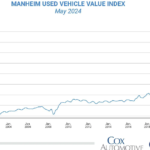In 1978, marketing manager Gary Thurk launched the first commercial email marketing campaign, announcing a new line of computers to 400 email recipients. Since then, email has grown to become one of the most important channels for marketers, small business owners, and e-commerce entrepreneurs. One study predicts By 2026, there will be more than 4.7 billion email users worldwide.
But what’s the best way to evaluate your email marketing efforts? investigationIn 2015, over a quarter of email marketers said that conversion rate is a key metric for the success of their email marketing campaigns. Learning how to calculate your email marketing conversion rate can help you take an important step towards improving your conversion rates.
What is your conversion rate in email marketing?
Email conversion rate is a metric that measures the percentage of email recipients who take a desired action after opening an email — often a specific conversion goal, such as purchasing a product, signing up for a service, downloading a resource, being redirected to a website, or claiming a promotion.
Email marketing conversion rate is an important metric when it comes to marketing. Email Campaigns It gives you insight into how well your campaigns are performing and how you can improve them. By calculating the conversion rate of your email marketing campaigns, you can identify the strengths and weaknesses of your campaigns and adjust your marketing strategy accordingly to drive more conversions.
How to Calculate Email Marketing Conversion Rates
To calculate your email marketing conversion rate, divide the number of email recipients who completed a desired action by the number of emails delivered, then multiply that result by 100 to get a percentage.
The formula for calculating email conversion rate is:
(Conversions / number Delivered email) x 100 = Email Conversion Rate
For example, if you sent 1,000 emails with the goal of driving traffic to your website, start by finding out how many of them were sent successfully without bouncing back or being flagged as spam (most email marketing platforms provide these analytics).
Next, you want to see how many of your email recipients opened the email and clicked through to your website. If your 960 emails were successfully delivered and 48 of the recipients clicked through to your website and completed the desired action, the calculation would be:
(48 conversions / 960 emails sent) x 100 = 5% email conversion rate
What is a good conversion rate for email marketing?
The right conversion rate will vary depending on your industry, company, and email campaign. However, the average conversion rate for emails is usually between 2% and 5%. For example: In one survey The average email conversion rate for automated welcome emails sent by ecommerce businesses in 2022 was 3%.
Tips to improve your email marketing conversion rates
Factors that negatively impact your average conversion rate include poor email list hygiene (e.g., typos in addresses), spam-inducing words in subject lines, irregular sending frequency (too many or too few emails sent at random times), etc. Here are some ways to improve the effectiveness of your email marketing efforts.
Maintain good email list hygiene
Email list hygiene is the process of keeping your list of email subscribers clean, accurate, and engaged. If your email list contains invalid email addresses, Email deliverability This can result in fewer emails reaching recipients’ inboxes and a lower overall email conversion rate.
Regularly remove invalid email addresses. Make it easy for recipients to unsubscribe from your email list by adding a clear unsubscribe button to your emails. Making it easy to unsubscribe from your email list may seem counterintuitive, but it ultimately helps you maintain a quality list of engaged recipients.
Write a compelling subject line
Create a compelling email subject line that grabs attention and clearly communicates the benefits. Keep your subject line to 50 characters or less and avoid spammy phrases (such as “Sign up now” or “cash bonus”) and too many special characters like exclamation points, which may trigger filters and send your email to the spam folder. Be sure to provide any relevant content you promise in your subject line.
Include a clear call to action
When developing your email marketing strategy, set clear conversion goals. Attention-grabbing call-to-action (CTA) buttons It encourages readers to click and, most importantly, take action. Design your email to draw attention to your CTA button. Visuals and wording can have a big impact on your email conversion rates.
For example, if you launch an email campaign with the goal of acquiring new customers, Production lineInclude a bold CTA button with aggressive language such as “Buy Now” or “Add to Cart.” Consider setting up a dedicated landing page for your CTA button to drive a specific conversion.
A CTA button for your new product line can link to a landing page that highlights the benefits of that product and provides an easy checkout option.
Personalize your email
Instead of sending the same email to everyone on your email list, send personalized emails that address the recipient’s specific interests and needs. Personalized emails include the recipient’s name, as well as information related to their previous purchase history and behavior in your online store.
Starting with Email segmentationSegment your email list into smaller groups based on factors like demographic data, purchase history, customer behavior, etc. Segmenting your email subscribers into target groups allows you to send more relevant email campaigns tailored to each segment. For example, you can create welcome emails for new customers and follow-up emails for those whose customers are interested. Abandoned shopping cart.
Optimize your emails for mobile
Increase conversions by optimizing your campaigns for mobile devices. One study reported: Mobile e-commerce sales are expected to exceed $2.2 trillion by 2023, accounting for approximately 60% of global e-commerce sales.
Mobile optimization techniques include compressing images to improve load times, using a single-column layout with simple horizontal navigation, and creating responsive templates that allow mobile users to easily interact with your email on their phones.
How to run an e-commerce business Shopify You get access to built-in email marketing tools Shopify Email This allows you to easily create email campaigns with mobile-responsive templates, helping you improve conversions.
Use an email sequence automation tool
To further increase the conversion rate of your email campaigns, use automation tools. Shopify Email, Active Campaignand Omnisend It offers automation capabilities and allows you to set up email sequences (a series of automated emails that vary based on user behavior).
For example, you can set up a welcome email sequence to maximize engagement with new subscribers and encourage them to take a specific action, like sharing feedback on your products or services. You can drive conversions through automated email sequences, saving you time and money while targeting your customers with relevant information where they are. Sales Pipeline.
Test and tweak your email campaigns
Embed A/B Testing(Also known as split testing) Send two different versions of a marketing email to two different groups on your email list and compare and contrast the results. Pursue the version that gets the best results and adjust your email campaign based on the feedback.
Comparing campaign performance gives you insights on how to optimize email engagement and create emails that drive more conversions. Email Marketing Metrics Analyze click-through rates, bounce rates, unsubscribe rates, and more to evaluate the success of your campaigns.
Email Conversion Rate FAQs
How can you increase your email conversion rates?
Some of the conversion rate optimization strategies you can implement include clear call-to-action (CTA) buttons, personalized messaging, email automation tools, and emails optimized for mobile users.
How does conversion rate in email marketing relate to ROI?
Your conversion rate directly impacts your return on investment (ROI): the higher your conversion rate, the lower it costs to encourage a particular action, resulting in a higher ROI for your email marketing.
What are some common conversion rate challenges with email marketing?
Some of the most common challenges with email marketing conversion rates include finding the right email sending frequency, sending the same email to everyone on your email list without personalization, and using phrases or design elements that trigger spam filters.







